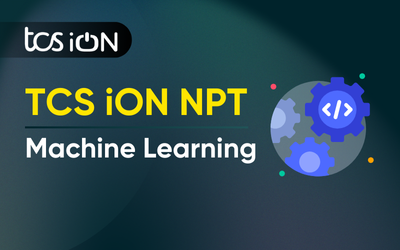TCS NPT Machine Learning
Machine learning is one of the most exciting fields in technology today, shaping everything from self-driving cars to recommendation systems on social media. The TCS NPT Machine Learning course is designed to provide individuals with the foundational knowledge and practical experience needed to excel in this fast-evolving area. It covers key machine learning concepts, algorithms, and tools while providing both theoretical understanding and practical application through a structured exam format.
What You Will Learn From Skill Vertex Machine Learning Course?
The TCS NPT Machine Learning course is ideal for those looking to understand the basics of machine learning, as well as for those who want to deepen their knowledge and practical skills in this area. The course is designed to offer a balance between theory and practice, ensuring that learners not only understand machine learning concepts but can also apply them to real-world problems.
The course is divided into two parts:
- Part A: Knowledge Test – This section evaluates your understanding of core machine learning concepts.
- Part B: Application Test – This part assesses your ability to apply what you've learned through case studies and practical examples.
Core Areas of Machine Learning Covered in the Course
1. Basics of Statistics
Statistics is the foundation of machine learning. The course introduces both basic and advanced statistical concepts that are essential for understanding data patterns and building models. Topics include:
- Matrices and vectors
- Distance measures (Euclidean, Manhattan, Mahalanobis, Minkowski)
- Descriptive statistics, probability, and hypothesis testing
- Regression techniques
2. Introduction to Machine Learning
In this section, you will get familiar with machine learning terminologies and learn about various algorithms used in the field. The course explains the different types of learning:
- Supervised Learning: You will learn about algorithms like Linear and Logistic Regression that help predict outcomes based on labeled data.
- Unsupervised Learning: Learn techniques like K-means and Agglomerative Clustering that help identify patterns in unlabeled data.
- Reinforcement Learning: Understand the basics of reinforcement learning, which involves learning from actions and feedback in dynamic environments.
3. Machine Learning Methodology
The course delves into methodologies like CRISP-DM (Cross-Industry Standard Process for Data Mining) and explains how to manipulate and prepare data for machine learning algorithms. Topics include:
- Handling missing data (imputation)
- Data normalization and transformation
- Dimensionality reduction techniques such as Principal Component Analysis (PCA)
- Understanding multicollinearity and its impact on models
4. Key Concepts of Machine Learning
This section covers essential concepts that form the backbone of machine learning. You will explore:
- Different supervised and unsupervised learning algorithms
- Model evaluation and validation techniques, including confusion matrices, ROC curves, and cross-validation
- Understanding overfitting vs. underfitting, and how to avoid them
- Using Synthetic Minority Over-sampling Technique (SMOTE) to handle data imbalance
5. Machine Learning Algorithms
The course also covers a variety of machine learning algorithms used for solving real-world problems, including:
- Clustering Algorithms: Techniques like K-means and Hierarchical Clustering that group similar data together.
- Decision Trees: Learn algorithms such as ID3 and CHAID, which are used to make decisions based on data.
- Random Forests and SVM: Explore ensemble methods and Support Vector Machines for classification and regression tasks.
6. Exploratory Data Analysis (EDA)
Exploratory Data Analysis (EDA) is essential for understanding data before building machine learning models. The course provides you with skills to:
- Analyze datasets visually
- Identify patterns and trends in the data
- Perform data merging and dimensionality reduction
- Understand issues like multicollinearity that affect the model's performance
TCS NPT Machine Learning Exam Structure
The course is divided into two sections:
| Part |
No. of Questions |
Marks |
Duration (Minutes) |
Details |
| Part A: Knowledge Test |
20 |
20 |
25 |
Covers key concepts like SEO, PPC, and UX. |
| Part B: Application Test |
6 (Case Studies) |
20 |
35 |
Focuses on applying knowledge to practical scenarios in website and campaign management. |
| Total |
26 |
40 |
60 |
Combined evaluation of knowledge and application. |
TCS NPT Machine Learning Syllabus
Part A Syllabus - Test of Knowledge (Machine Learning)
| Sr. No. |
Module Descriptor |
Topics Covered |
Details |
| 1 |
Basics of Statistics |
Basic and advanced concepts of statistics |
Matrices, vectors, matrix operations, distance measures (Euclidean, Manhattan, Mahalanobis, Minkowski), descriptive statistics, probability, hypothesis testing, regression |
| 2 |
Basics of Machine Learning |
Introduction to machine learning terminologies and algorithms |
Supervised learning (Linear & Logistic Regression), Unsupervised learning (K-means, Agglomerative Clustering), Reinforcement learning basics |
| 3 |
Machine Learning Methodology |
CRISP-DM methodology and data manipulation |
CRISP-DM steps, handling missing data (imputation), normalization, data transformation, dimensionality reduction, PCA, multicollinearity |
| 4 |
Key Concepts of Machine Learning |
Concepts related to supervised/unsupervised learning algorithms, model evaluation, and validation |
Linear & Multiple Linear Regression, Logistic Regression, GBM, model validation (Confusion matrix, ROC Curve, Cross-validation), overfitting vs. underfitting, SMOTE |
| 5 |
Machine Learning Algorithms |
Real-life use cases involving clustering algorithms, decision trees, and random forests |
K-means, Hierarchical Clustering, KNN, Decision Trees (ID3, CHAID), Naïve-Bayes, Random Forests, SVM |
| 6 |
Exploratory Data Analysis (EDA) |
Analyzing datasets using visual methods and summarizing main characteristics |
Data merging, dimensionality reduction, multicollinearity |
Part B Syllabus - Test of Application (Machine Learning)
| Sr. No. |
Module Coverage |
Skill Assessed |
| 1 |
Data Wrangling and Exploratory Data Analysis (EDA) |
Working knowledge of EDA, probability, Maximum A Posteriori (MAP) estimation, and Maximum Likelihood Estimation (MLE) |
| 2 |
Python for Machine Learning |
Programming concepts and hands-on application in machine learning using Python |
| 3 |
Supervised Machine Learning Algorithms |
Practical approach to solving real-world problems using supervised learning techniques with Python |
| 4 |
Data Exploration and Preprocessing Practice |
Data preparation, handling data imbalance, and preprocessing techniques for machine learning |
Skills You Will Develop With Skill Vertex Machine Learning Course
By the end of the TCS NPT Machine Learning course, you will have gained essential skills, including:
- Data Handling: Learn how to prepare, clean, and manipulate data for machine learning models.
- Algorithm Implementation: Gain experience with various machine learning algorithms like Linear Regression, K-means, and Decision Trees.
- Model Evaluation: Learn how to assess and improve the performance of machine learning models using techniques like cross-validation and ROC curves.
- Practical Application: Work on real-world problems and case studies that help you apply machine learning to solve challenges across different industries.
Why Choose the TCS NPT Machine Learning Course?
The TCS NPT Machine Learning course provides a comprehensive and practical approach to mastering machine learning. Whether you're new to the field or want to refine your skills, this course provides both the theoretical foundations and hands-on experience you need to excel in machine learning. The combination of theoretical knowledge and practical case studies ensures you not only learn about machine learning but also understand how to apply it to solve real-world problems.
With machine learning being one of the most in-demand skills in technology today, completing this course can open doors to a wide range of career opportunities, from data scientist to AI engineer and beyond.
 3 months
3 months 11 modules
11 modules 3 months
3 months 12 modules
12 modules 3 months
3 months 15 modules
15 modules 3 months
3 months 9 modules
9 modules 3 months
3 months 6 modules
6 modules 3 months
3 months 7 modules
7 modules 3 months
3 months 11 modules
11 modules 3 months
3 months 10 modules
10 modules 3 months
3 months 13 modules
13 modules 6 months
6 months 12 modules
12 modules 3 months
3 months 8 modules
8 modules 3 months
3 months 10 modules
10 modules 3 months
3 months 17 modules
17 modules 3 months
3 months 16 modules
16 modules 3 months
3 months 8 modules
8 modules 3 months
3 months 7 modules
7 modules











